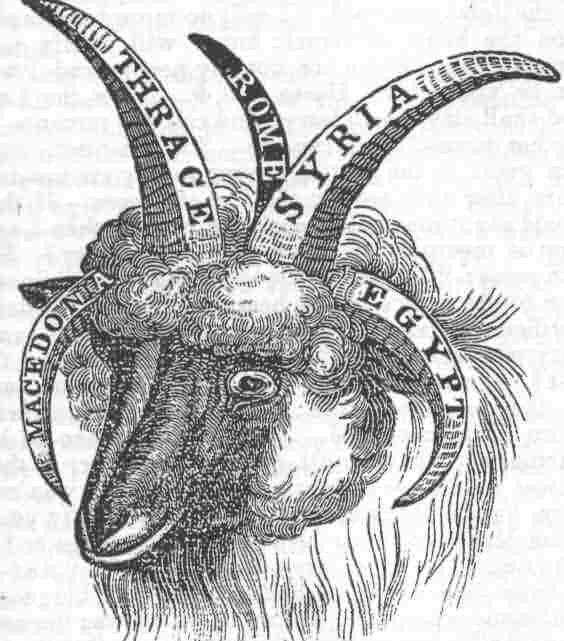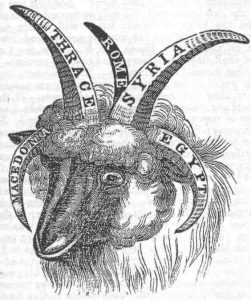Lest any of us are timid about this week’s lesson title, and not sure this study conforms to your limited theological abilities, let’s clear up this mystery first off. Eschatological, as it briefly explained last week, just means pertaining to the end times of earth’s history or the destiny of mankind. And the pronunciation (which you were probably able to avoid last week, when it wasn’t in the title of the lesson) is not that mystical either. Just remember the “ch” sounds like a “k” and the last part of the word is pronounced “logical”, as in the word “logical”.
This lesson is very important though, because it makes a critical link with chapters 7, 8, and 9 of Daniel. And we need, as Daniel did, all the information we can accumulate in order to understand the prophecies being unfolded here.
In Lesson 6, several weeks ago, we studied the Day of Atonement from the perspective of the earthly sanctuary ritual, and this was a vital background as we now study the Day of Atonement from a heavenly viewpoint. As we’ve established this quarter, the earthly sanctuary is just a model (or type) of the real one in heaven (the antitype).
Memory Text: “And he said unto me, Unto two thousand and three hundred days; then shall the sanctuary be cleansed.” Daniel 8:14 KJV [all emphases, by author]
That great judgment scene that we saw unfolded in Daniel 7 last week is going to be the same event as the cleansing of the sanctuary, mentioned in our memory text.
We again come across some beasts that Daniel saw in vision (Daniel 8:3-8). The two beasts this time were a ram (representing Media-Persia; by this time Babylon had fallen), and a he-goat (representing Greece). They were specifically identified in the interpretation of the vision (v. 20-22).
History has born out the correctness of this interpretation. The two horns on the ram symbolized the kings of Media and Persia. But Daniel would have no way of knowing about the “great horn”, or the first king of the he-goat creature, identified by many as the Grecian emperor Alexander the Great.
In verse 22, following Alexander’s death, we can also see four kingdoms that come out of the Grecian empire that would be the four “notable ones” (v. 8), the divisions of Macedonia, Asia Minor, Syria, and Egypt.
The next power seen in the vision is the little horn, or Rome, both in its pagan and papal capacities.
Sunday: The Little Horn’s Attack
We are now ready to see the work of this little horn, spoken of in Daniel 8: 9-14, 23-25. Since its power rises up directly after the ram and the he-goat kingdoms, it makes sense to look at the next kingdom on earth, which was Rome. Indeed, as pagan Rome became papal Rome, we see all of the identification marks of the little horn pointing to the papacy’s unusual power over political figures (monarchs at the time), making it the diverse and terrifying beast we saw in Daniel 7.
Here are the entities under attack by this little horn (also symbolized as the “beast” in Revelation):
- He usurps the role and responsibilities of the heavenly High Priest Jesus Christ. “Yea, he magnified himself even to the prince of the host,…” Daniel 8:11 KJV
- He interrupts God’s worship on earth. “…and by him the daily sacrifice was taken away, and the place of his sanctuary was cast down.” Daniel 8:11 KJV
- Truth is at risk. “…and it cast down the truth to the ground…” Daniel 8:12 KJV
- God’s saints are suffering. “Then I heard one saint speaking, and another saint said unto that certain saint which spake, “How long…?” Daniel 8:13 KJV
These attacks are mirrored in the many innovations instituted by the papal powers during this historical period, such as:
- a mediating priesthood
- the sacrifice of the mass
- the confessional
- the worship of Mary
Discussion Questions: Some theologians claim another interpretation to explain the activities of the little horn. Why are communism and even Islam not appropriate interpretations for this prophecy? Why is it important to remember that we are dealing only with Rome here?
How can we remain faithful to our beliefs in this without hurting others of differing faiths?
Monday: “How Long?”
“…How long shall be the vision concerning the daily sacrifice, and the transgression of desolation, to give both the sanctuary and the host to be trodden under foot?” Daniel 8:13 KJV
This plea of the saints is more than a request for a definite time element. It’s also an expression of lament, of a desire for circumstances to change, even a call for divine justice. Many of us, when we are about to drown in our sorry states, are filled with the question to God, “How long, O Lord?”
In return, the Lord has given us the entreaty many times through His prophets, “…How long halt ye between two opinions? if the Lord be God, follow him: but if Baal , then follow him.” I Kings 18:21 KJV
The saints AND God are longing for the day when this old world is no more and we are reunited with our God. The relationship will be fully restored and we will be eternally safe from sin.
“Nevertheless we, according to his promise, look for new heavens and a new earth, wherein dwelleth righteousness.” II Peter 3:13 KJV
Discussion Questions: Jesus said in John 14:1-3 that He is going to heaven to prepare a place for us. As Creator, He could do this instantly, so why is it taking Him so long?
Are His promises still valid today?
Tuesday: Restoration of the Holy
Daniel immediately receives an answer this time when he wonders and frets about how long before this prophecy is fulfilled. Daniel 8:14 tells us, “And he said unto me, Unto two thousand and three hundred days; then shall the sanctuary be cleansed.” Daniel 8:14 KJV
The cleansing of the sanctuary could denote the restoration of the holy, as the words are used interchangeably in the Bible. But in the context of the sanctuary, cleansing and purification are most appropriate to use. Hence, we are still bound to examine the sanctuary services to unlock this prophecy. With all the preparation and soul searching before the Day of Atonement, the entire camp and its people were declared holy and clean, when the ceremony was complete.
Here are the results of this restoration:
- judgment against the little horn power
- the sanctuary will be cleansed or purified
- God’s people will be given their reward
Discussion Questions: How does the first angel’s message in Revelation 14:6-7 (see below) relate to the judgment of Daniel 7 and the cleansing of the sanctuary in Daniel 8? What is the task of the remnant in the time of the end?
“And I saw another angel fly in the midst of heaven having the everlasting gospel to preach unto them that dwell on the earth, and to every nation, and kindred, and tongue, and people, Saying with a loud voice, Fear God, and give glory to him; for the hour of his judgment is come: and worship him that made heaven, and earth, and the sea, and the fountains of waters.” Revelation 14:6-7 KJV
Wednesday: Day of Atonement in Daniel 8
“And an host was given him against the daily sacrifice by reason of transgression, and it cast down the truth to the ground; and it practiced, and prospered. Then I heard one saint speaking, and another saint said unto that certain saint which spake, How long shall be the vision concerning the daily sacrifice, and the transgression of desolation, to give both the sanctuary and the host to be trodden under foot?” Daniel 8:12-13 KJV
The language used in the above text certainly shows the little horn to be in a state of rebellion against God. These are defiant sins, the ones described in Leviticus 16:16, 21. The cleansing of the sanctuary was the prescribed method for resolving transgressions of this type. Not only did it restore the sanctuary to its pure and holy state, but God’s people enjoyed the purification this ceremony brought to the camp also.
Thus:
- truths taught in the sanctuary are restored,
- the people are purified (justified and sanctified from their sins),
- and the ultimate result, God Himself is vindicated before the universe.
Discussion Questions: How do we know that the cleansing of the sanctuary and the pre-Advent judgment, studied last week, are the same event?
Why must all our teachings, including the judgment, be taught in the context of the cross? What does Calvary have to do with our atonement? What does the atonement mean to you?
Thursday: Daniel 8 and 9
The only time period mentioned in Daniel 8 is the 2300 days (v. 14). Since the interpretation specifically included the kingdoms of Media-Persia and Greece, followed by Rome, we must conclude that a large time span is being spoken of here. Therefore, it seems imperative that we interpret the 2300 days using prophetic time, with each day as a year. (See Numbers 14:34 and Ezekiel 4:6.)
Our problem is we don’t have a starting point for the beginning of this prophecy to see when it would end. That is why we need to include chapter 9 of Daniel in our study.
Unlike the two previous chapters where Daniel is given a dream and then an interpretation of that dream, chapter 9 launches almost immediately into a prayer by Daniel, following his desire to understand a prophecy of Jeremiah that spoke of 70 weeks of desolation for Jerusalem.
Gabriel appears to Daniel several years after the vision that included the 2300-days prophecy. He says in Daniel 9:23, “…therefore understand the matter, and consider the vision.” Since he has received no new vision, we must assume that the revelation he now gives would encompass this longest-time prophecy in God’s word, the 2300-days or years from his last vision.
Daniel 9:24 addresses the seventy-weeks prediction that Daniel was concerned about. The wording that “Seventy weeks are determined upon thy people…” is probably better translated “cut off” rather than “determined”. I checked the Hebrew word in my Strong’s Concordance to verify this. It’s an important finding, because it informs us that these 70-weeks are included (apportioned) within the 2300-days.
In verse 25 we are given the date we so long crave. This beginning date and end date for the 70 weeks was “from the going forth of the commandment to restore and to build Jerusalem unto the Messiah the Prince.” KJV
Although Ezra reports three different decrees to rebuild the holy city, the most effective one which called for the rebuilding of the city AND the temple was by King Artaxerxes I in 457 B.C.
 Discussion Questions: Why are these things important for God’s people today to understand? [“All need a knowledge for themselves of the position and work of their great High Priest. Otherwise it will be impossible for them to exercise the faith which is essential at this time or to occupy the position which God designs them to fill.” ~The Great Controversy, p. 488]
Discussion Questions: Why are these things important for God’s people today to understand? [“All need a knowledge for themselves of the position and work of their great High Priest. Otherwise it will be impossible for them to exercise the faith which is essential at this time or to occupy the position which God designs them to fill.” ~The Great Controversy, p. 488]
Next Week: Our Prophetic Message











